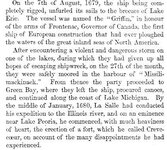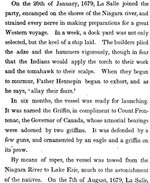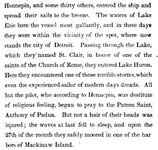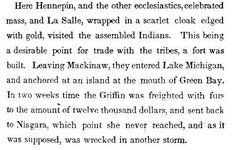diverlynn
Hero Member
By JOHN FLESHER • Associated Press • January 30, 2009
TRAVERSE CITY — The French government says it still owns the Griffin, a 17th-Century ship built by legendary explorer La Salle that may have been discovered in northern Lake Michigan.
France filed a claim to the vessel Tuesday in U.S. District Court in Grand Rapids, escalating a legal battle over who owns and has authority to retrieve artifacts from the long-lost vessel.
Michigan also is seeking title, although state officials have raised doubts about whether the Griffin’s gravesite actually has been found. They say federal law gives the state ownership of abandoned vessels embedded in its Great Lakes bottomlands.
A private group, Great Lakes Exploration LLC, located what it contends may be the Griffin’s wreckage in 2001. It wants to be appointed custodian until the courts determine ownership and salvage rights.
The precise site has not been publicly revealed, but is believed to be between Escanaba and the St. Martin Islands, near Wisconsin.
The Griffin (also spelled “Griffon”) disappeared on its maiden voyage in 1679 after embarking from an island near Green Bay, Wis., with a crew of six and a cargo of furs and other goods.
France filed paperwork with the court this week to meet a deadline for avoiding loss of rights to the ship, a spokesman for the French embassy in Washington said Thursday.
The claim is based on documents showing the fatal expedition was undertaken on behalf of the French crown and was not a private venture, the spokesman said.
Steve Libert, spokesman for Great Lakes Exploration, backs the claim. “Michigan isn’t fighting just me any more. They’re fighting the country of France,” he said.
Matt Frendewey, spokesman for the Michigan Attorney General’s Office, said state officials were reviewing the French court filing and would respond later.
In a motion filed last month, Michigan asked federal judge Robert Holmes Bell to declare the wreckage — if it exists — state property. Assistant Attorney General Louis Reinwasser said divers visited the site in October and found only a timber protruding from the lake bottom.
Ken Vrana, director of the Lansing-based Maritime Center, said a sonar examination of the site in 2006 detected numerous artifacts on the bottom and embedded in sediments.
His nonprofit scientific and educational organization is working with Libert on plans for a remote sensing expedition this summer in hopes of identifying the artifacts. France’s director of underwater archaeology has endorsed the mission, Vrana said.
“I would still love to do it on a cooperative basis with the State of Michigan and I’m perplexed as to why they are resisting,” he said.
TRAVERSE CITY — The French government says it still owns the Griffin, a 17th-Century ship built by legendary explorer La Salle that may have been discovered in northern Lake Michigan.
France filed a claim to the vessel Tuesday in U.S. District Court in Grand Rapids, escalating a legal battle over who owns and has authority to retrieve artifacts from the long-lost vessel.
Michigan also is seeking title, although state officials have raised doubts about whether the Griffin’s gravesite actually has been found. They say federal law gives the state ownership of abandoned vessels embedded in its Great Lakes bottomlands.
A private group, Great Lakes Exploration LLC, located what it contends may be the Griffin’s wreckage in 2001. It wants to be appointed custodian until the courts determine ownership and salvage rights.
The precise site has not been publicly revealed, but is believed to be between Escanaba and the St. Martin Islands, near Wisconsin.
The Griffin (also spelled “Griffon”) disappeared on its maiden voyage in 1679 after embarking from an island near Green Bay, Wis., with a crew of six and a cargo of furs and other goods.
France filed paperwork with the court this week to meet a deadline for avoiding loss of rights to the ship, a spokesman for the French embassy in Washington said Thursday.
The claim is based on documents showing the fatal expedition was undertaken on behalf of the French crown and was not a private venture, the spokesman said.
Steve Libert, spokesman for Great Lakes Exploration, backs the claim. “Michigan isn’t fighting just me any more. They’re fighting the country of France,” he said.
Matt Frendewey, spokesman for the Michigan Attorney General’s Office, said state officials were reviewing the French court filing and would respond later.
In a motion filed last month, Michigan asked federal judge Robert Holmes Bell to declare the wreckage — if it exists — state property. Assistant Attorney General Louis Reinwasser said divers visited the site in October and found only a timber protruding from the lake bottom.
Ken Vrana, director of the Lansing-based Maritime Center, said a sonar examination of the site in 2006 detected numerous artifacts on the bottom and embedded in sediments.
His nonprofit scientific and educational organization is working with Libert on plans for a remote sensing expedition this summer in hopes of identifying the artifacts. France’s director of underwater archaeology has endorsed the mission, Vrana said.
“I would still love to do it on a cooperative basis with the State of Michigan and I’m perplexed as to why they are resisting,” he said.







